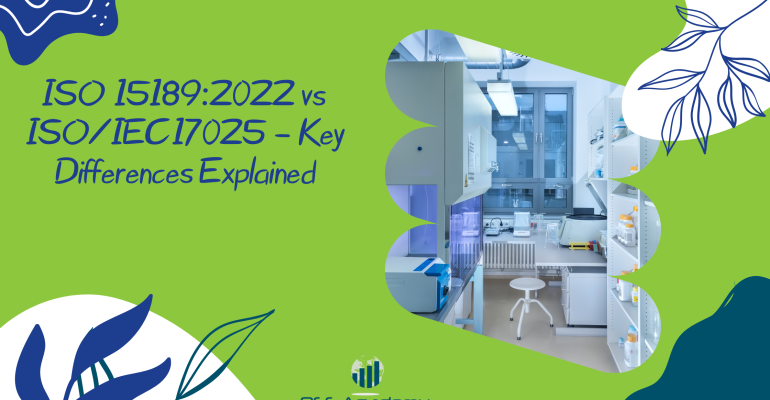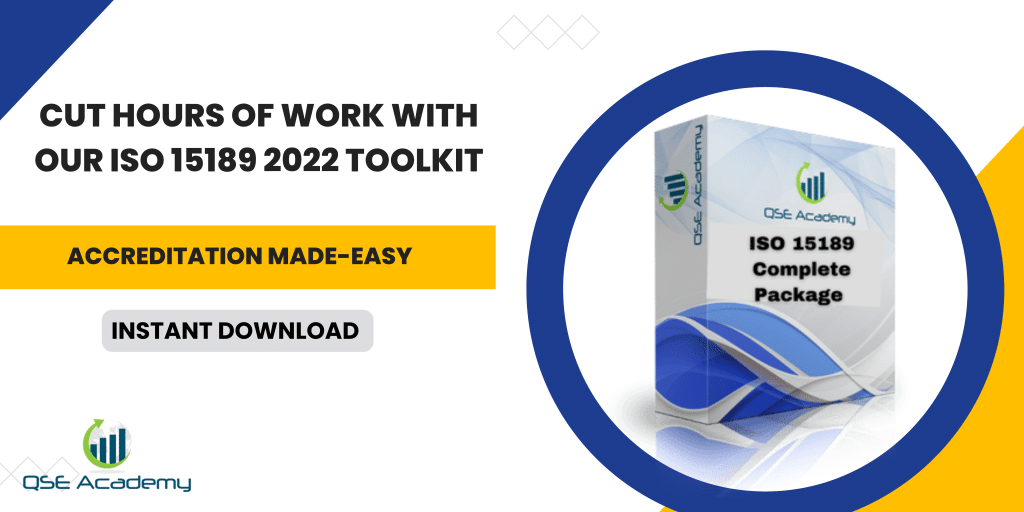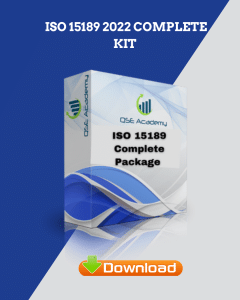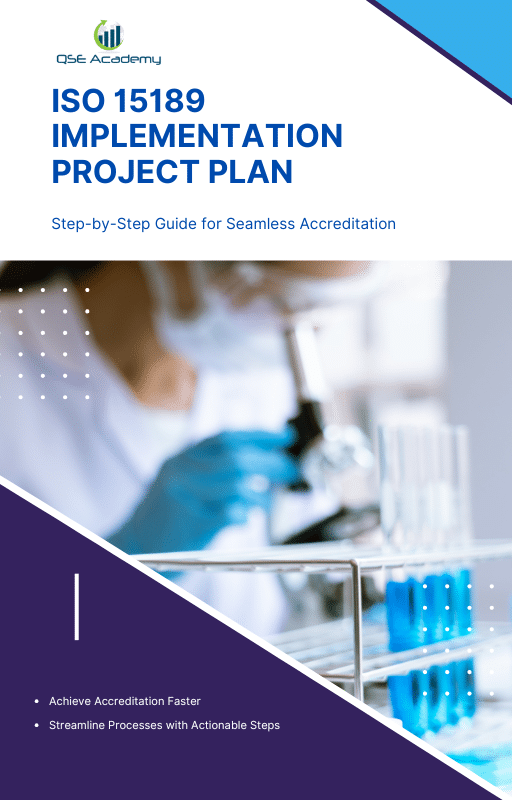ISO 15189:2022 vs ISO/IEC 17025 – Key Differences Explained
Last Updated on October 22, 2025 by Hafsa J.
Understanding the Link Between Laboratory and Testing Accreditation
Most labs I work with ask the same question early on:
“What’s the difference between ISO 15189 and ISO/IEC 17025—and which one do we actually need?”
It’s a fair question. On paper, both standards look similar. They talk about competence, impartiality, and consistent results. But in reality, they serve very different worlds.
Here’s what I’ve noticed after helping both medical and calibration laboratories achieve accreditation:
ISO 15189 is designed for medical laboratories that test human samples for diagnosis or treatment. ISO/IEC 17025, on the other hand, focuses on testing and calibration labs that verify measurements and ensure traceability—think of labs testing materials, food, or equipment accuracy.
If you’re unsure which path fits your lab, this article will help you:
-
Understand how each standard is structured and applied.
-
Identify which one aligns with your operations and clients.
-
Avoid common pitfalls that cause confusion (and audit delays).
By the end, you’ll have a clear picture of where your lab fits—and how to prepare for accreditation confidently.
Purpose & Scope Comparison – Medical vs. Testing Laboratories
Let’s start with the foundation—why these standards exist and who they serve.
ISO 15189:2022 is designed for medical laboratories that perform tests directly related to patient diagnosis, treatment, or monitoring. Every clause in this standard connects back to patient safety, ethical responsibility, and clinical reliability.
ISO/IEC 17025:2017, on the other hand, is for testing and calibration laboratories across industries—manufacturing, research, environmental testing, food analysis, and more. Its purpose is to ensure technical competence, impartiality, and reliable measurement results.
Here’s how I usually explain it to clients:
-
If your lab produces results that impact a doctor’s medical decisions, ISO 15189 is your path.
-
If you test or calibrate materials, instruments, or environmental samples, ISO/IEC 17025 is your standard.
Pro Tip: Some organizations need both. For example, a hospital might run a calibration section (covered by ISO 17025) and a clinical diagnostic lab (covered by ISO 15189). Overlap happens—but the intent behind each standard stays distinct.
Common Mistake to Avoid:
Assuming ISO 17025 automatically covers medical testing. It doesn’t. Auditors will expect evidence of clinical governance, ethical practices, and patient result validation—all specific to ISO 15189.
Now that we’ve clarified the purpose and audience, let’s look at how these two standards are structured clause-by-clause.
Structural Framework – ISO 15189:2022 vs ISO/IEC 17025:2017 Clauses
Now that we know the “why,” let’s talk about the “how.”
Both ISO 15189 and ISO/IEC 17025 follow a process-based structure, aligned with ISO 9001 principles. But they’re built with different priorities in mind.
Here’s a simple breakdown:
| Category | ISO 15189:2022 | ISO/IEC 17025:2017 |
|---|---|---|
| Focus | Medical laboratories and patient safety | Testing & calibration laboratories |
| Clause Structure | 8 main clauses | 8 main clauses |
| Emphasis | Risk management, ethics, patient results | Technical competence and traceability |
| Context | Healthcare settings | Industrial and scientific applications |
What’s interesting:
ISO 15189:2022 actually adopted several elements from ISO/IEC 17025:2017—especially in how competence and impartiality are defined. However, it expanded further to cover clinical governance and patient-centered processes, which ISO 17025 never touches.
In my experience, when labs transition from ISO 17025 to ISO 15189, they often struggle with the ethical and medical dimensions—such as consent handling or confidentiality of patient data. The technical part feels familiar, but the clinical quality management side is where the challenge lies.
Pro Tip:
When building or revising your quality manual, create a clause-mapping matrix. It visually connects ISO 15189 and ISO 17025 requirements side-by-side. This helps multi-standard labs avoid redundant documentation and impress auditors with alignment clarity.
Now that you understand how both standards are structured, let’s move to what really matters in daily operations—competence and personnel requirements.
Competence & Personnel Requirements – Technical vs. Clinical Expertise
Both standards agree on one thing: people make or break laboratory quality.
But how they define “competence” differs sharply.
In ISO/IEC 17025, competence is mostly about technical skill and calibration accuracy. Staff must be able to perform tests correctly, use equipment properly, and ensure measurement traceability. The focus is on technical reliability.
ISO 15189 raises the bar. It goes beyond technical know-how and adds a clinical dimension — requiring laboratories to ensure that test results are medically valid and interpreted correctly by qualified professionals.
That means your team must include personnel such as:
-
Medical technologists
-
Pathologists or clinical scientists
-
Quality managers with medical laboratory training
In my experience, this is where medical labs often underestimate the requirements.
A lab might have brilliant technicians but lack documented evidence of clinical oversight — and that’s an instant non-conformity in ISO 15189 audits.
Pro Tip:
Create a competence matrix that covers both technical and clinical roles. Define not only the skill level (e.g., “can operate spectrophotometer”) but also the responsibility level (e.g., “reviews test results before release”). This distinction demonstrates control over both quality and patient safety.
Common Pitfall:
Reusing ISO 17025 training records for ISO 15189 accreditation. They’re not interchangeable. ISO 15189 expects medical validation, continuing education, and clinical accountability, not just calibration proficiency.
Now that we’ve covered the people side, let’s look at how processes differ — from testing and calibration to handling patient samples and results.
Process Requirements – Managing Tests, Calibrations, and Patient Results
This is where the two standards start to diverge in real-world application.
Both ISO 15189 and ISO/IEC 17025 focus on process control—but the type of process is what sets them apart.
In ISO/IEC 17025, the process covers testing or calibration activities. The emphasis is on ensuring that every measurement is traceable to international standards and that uncertainty is properly calculated. Think of it as: Can we prove this instrument or test method gives accurate, repeatable results?
In ISO 15189, the process spans the entire patient testing journey—from pre-examination (sample collection) to post-examination (reporting and interpretation). Accuracy still matters, but now it’s tied to patient care, risk management, and ethical responsibility.
Here’s an example from one of my clients:
A calibration lab under ISO 17025 focused on instrument accuracy—verifying thermometers and balances. When they transitioned to ISO 15189 for their hospital’s diagnostic section, they had to add steps for sample identification, consent handling, and result confidentiality.
Technically similar tools—but a totally different quality mindset.
Pro Tip:
If your organization performs both calibration and diagnostic work, develop a hybrid process map. Identify shared steps (like equipment verification) but separate medical-specific controls (like patient result validation). Auditors love this clarity.
Pitfall to Avoid:
Using a generic testing workflow for patient results. Under ISO 15189, you must document how results are authorized, who reviews them, and how errors are managed—especially if they could affect patient outcomes.
Now that you’ve seen how operations differ, let’s explore how both standards handle quality management systems and continual improvement.
Management System Requirements – Quality and Risk Integration
Both standards require a management system, but their intent and flexibility differ.
In ISO/IEC 17025, you have two options:
-
Option A: Follow the built-in quality clauses within the standard.
-
Option B: Use an external system like ISO 9001, as long as it meets 17025’s intent.
This gives testing and calibration labs freedom to design a lean, efficient system focused on technical competence and traceability.
ISO 15189, however, takes a broader view. It integrates risk-based thinking, continual improvement, and patient safety management directly into its core structure. There’s no “Option B.” Your management system must actively control both technical and clinical risks.
In practice, that means adding procedures for:
-
Incident management (e.g., reporting critical errors that might affect patient care)
-
Corrective and preventive action (CAPA) with medical context
-
Patient feedback and complaint handling
-
Ongoing risk assessment for testing processes and result accuracy
In my experience, many labs transitioning from ISO 17025 underestimate how central risk management is in ISO 15189:2022. It’s not just a section—it’s a thread running through the entire standard.
Pro Tip:
Use a risk register that captures both technical and clinical risks side-by-side. For instance, “equipment calibration drift” (technical) and “incorrect patient sample labeling” (clinical). It’s a practical way to show auditors you understand your risks from both perspectives.
Pitfall to Avoid:
Treating ISO 15189 like a “stricter ISO 17025.” It’s not. It’s a different philosophy—where patient safety drives every quality decision, not just measurement accuracy.
Now that we’ve covered management systems, let’s look at how both standards interact with accreditation bodies and regulatory frameworks.
Accreditation & Regulatory Impact – Recognition and Application
Accreditation under ISO 15189 and ISO/IEC 17025 might sound similar, but the scope and regulatory weight can differ dramatically.
ISO/IEC 17025 accreditation is recognized globally through ILAC (International Laboratory Accreditation Cooperation) for testing and calibration competence. It’s the benchmark for proving that your lab produces technically valid, traceable results—whether you’re testing food, water, materials, or industrial components.
ISO 15189 accreditation, meanwhile, goes a step further. It not only confirms technical competence but also verifies medical reliability, ethical governance, and clinical accountability. That’s why it’s the standard of choice for medical and diagnostic laboratories under health authorities worldwide.
Here’s an example:
A hospital laboratory might hold ISO 15189 accreditation for clinical chemistry tests, while its equipment calibration section holds ISO/IEC 17025. The two accreditations serve different scopes but support the same organization’s quality ecosystem.
Pro Tip:
When applying for accreditation, clearly define your scope of activities—not just your standard. Many labs get delayed because their scope mixes medical and non-medical tests, confusing assessors. Define which processes fall under which standard before submission.
Pitfall to Avoid:
Assuming both accreditations are interchangeable. Regulators often require ISO 15189 specifically for medical testing, even if your lab already meets ISO/IEC 17025. Always check the national accreditation body’s recognition rules (like SANAS, UKAS, or A2LA).
Once you’ve identified your regulatory path, the next logical step is choosing which standard best fits your lab’s identity and long-term goals.
Choosing Between ISO 15189 and ISO/IEC 17025 – Decision Framework
Now comes the big question: which one should your lab choose?
The answer depends entirely on what you test, who you serve, and how your results are used.
Here’s the simplest way to look at it:
-
If your lab’s results are used for diagnosing or treating patients, go with ISO 15189.
-
If your lab performs testing or calibration for industrial, research, or commercial clients, ISO/IEC 17025 is the better fit.
-
If you do both, you may need both accreditations, with clearly defined scopes.
In my experience, some organizations start with ISO/IEC 17025 because it’s more general and easier to implement technically. As their operations expand into healthcare or diagnostic testing, they transition or add ISO 15189 to meet clinical requirements.
Pro Tip:
Run a gap analysis before deciding. Identify overlaps in your management system, competence framework, and documentation. Many clauses align—especially those covering impartiality, equipment control, and internal audits—so you can build a single integrated system that serves both standards efficiently.
Example:
A university lab providing environmental testing for research (ISO 17025) starts offering diagnostic microbiology for hospitals. Instead of rebuilding from scratch, they use their existing system as a foundation, then layer on ISO 15189’s clinical and ethical requirements.
Pitfall to Avoid:
Choosing a standard just because “it looks similar.” Accreditation assessors expect clear evidence that your chosen standard fits your operational purpose. Misalignment can lead to audit nonconformities and delays in approval.
Now that we’ve clarified how to choose, let’s wrap up with a few quick answers to the most common questions labs ask during this decision process.
FAQs – Clarifying Common Confusions
1. Can a laboratory hold both ISO 15189 and ISO/IEC 17025 accreditations?
Yes, absolutely. Many multidisciplinary labs maintain both. For instance, a hospital’s diagnostic lab may be accredited under ISO 15189, while its calibration or research unit holds ISO/IEC 17025. The key is to clearly define the scope of each accreditation so there’s no overlap or confusion during audits.
2. Which standard is more demanding—ISO 15189 or ISO/IEC 17025?
They’re demanding in different ways. ISO 17025 focuses on technical precision and measurement accuracy, while ISO 15189 adds another layer—clinical responsibility and patient safety. In other words, ISO 15189 includes everything that makes a test technically valid plus what makes it medically ethical and relevant.
3. Do both standards require proficiency testing?
Yes, but the intent differs. ISO 17025 requires proficiency testing to confirm technical competence and result reliability. ISO 15189 goes further—it ensures test outcomes are clinically meaningful and fit for patient care. So, while both involve inter-lab comparisons, ISO 15189’s programs are often patient-focused and risk-driven.
4. Can a lab transition from ISO/IEC 17025 to ISO 15189?
Yes, many labs do. If you already comply with ISO 17025, you’re halfway there in terms of quality management. The additional effort lies in implementing clinical governance, patient confidentiality, ethical testing procedures, and medical oversight. A structured transition plan or gap analysis is essential to make the shift smoothly.
Now that the key doubts are cleared, let’s close with the main takeaways and what action you should take next.
Aligning Quality with Purpose
At their core, both ISO 15189 and ISO/IEC 17025 share one mission: trustworthy, accurate, and reliable laboratory results.
The difference lies in who relies on those results.
ISO/IEC 17025 ensures industries, manufacturers, and research institutions get technically valid and traceable measurements.
ISO 15189 ensures healthcare providers and patients receive clinically sound, ethically managed test results that impact real lives.
In my experience, the most successful labs don’t view accreditation as a checkbox—they see it as a framework for excellence. Whether you’re calibrating instruments or diagnosing patients, both standards push you toward consistent quality, accountability, and continual improvement.
If you’re at the crossroads of choosing or expanding accreditation, start with a clear scope definition and a solid gap analysis. You’ll save months of confusion and align your lab with the right international recognition from the start.
Next Step:
If you’re ready to implement or transition between ISO 15189 and ISO/IEC 17025, QSE Academy’s documentation toolkits and training programs can help you streamline the process—without starting from scratch.
Whether it’s ISO 9001, ISO 22000, or the cosmetics-focused ISO 22716, I’ve spent my career I’m not here to call myself an expert—I prefer “enthusiast” because I truly love what I do. When I’m not writing about standards, you’ll probably find me playing Piano 🎹, connecting with people, or diving into my next big project💫. I’m an engineer specialized in the food and agricultural industry
make ISO standards less intimidating and more approachable for everyone.
turning complex jargon into clear, actionable steps that businesses can actually use.
There’s something incredibly rewarding about helping people navigate food safety and quality management systems
in a way that feels simple, practical, and even enjoyable.
I have a Master’s in QHSE management and over 12 years of experience as a Quality Manager
I’ve helped more than 15 companies implement ISO 9001, ISO 22000, ISO 22716, GMP, and other standards
My clients include food producers, cosmetics manufacturers, laboratories, and service companies
I believe quality systems should be simple, useful, and efficient.













